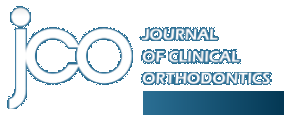Search Results For: 'case report'
2161.
Volume 9 : Number 4 : Page 187 : Apr 1975
Fireproof filing cabinets are a unique form of insurance and should be standard equipment in every orthodontic office. A reason for any insurance is to safeguard against a loss that one does not want ...
2162.
Overhead Projection: An Adjunct to Orthodontic Treatment
Volume 10 : Number 5 : Page 354 : May 1976
Overhead projection of prepared transparencies offers an opportunity for improved delivery of treatment in a busy practice by rapid retrieval of information at the chair on a routine visit basis. The ...
2163.
Special Considerations for Adult Orthodontics
Volume 10 : Number 7 : Page 535 : Jul 1976
Adult orthodontics is becoming a larger proportion of many practices. We are beginning to see more articles in our literature on subjects such as direct bonding and surgery, aimed at making orthodonti...
2164.
Volume 11 : Number 2 : Page 83 : Feb 1977
We are not going to resolve the question of the merit of myofunctional therapy in orthodontics in one issue of JCO, but we are presenting in this issue an extensive interview with a world authority on...
2165.
Volume 11 : Number 3 : Page 161 : Mar 1977
We have learned from articles about malpractice--Correcting and Preventing the Overbite of Malpractice Claims, September 1976 JCO; and JCO Interviews Aaron Rubin on Malpractice--Jan. issue--that the p...
2166.
Volume 12 : Number 7 : Page 467 : Jul 1978
There is a feeling on the part of many orthodontists that third party coverage of orthodontic treatment will eventually increase and that this will solve the economic problems in orthodontic practice....
2167.
Volume 14 : Number 6 : Page 369 : Jun 1980
There is a thesis that, for a variety of reasons--including the personality of people who make good students, the selection of good students by professional schools, and the nature of the professional...
2168.
Orthodontic Management of the Palatally Impacted Tooth
Volume 15 : Number 12 : Page 810 : Dec 1981
In most orthodontic techniques used to move impacted canines into the arch, the force usually comes from the labial archwire and is directed labially. However, when the canines are impacted high in th...
2169.
Volume 19 : Number 5 : Page 362 : May 1985
The mandibular corrector, or M.C. appliance, can be used instead of Class II elastics, headgears, and anterior repositioning appliances to correct Class II malocclusions. It can also be used together ...
2170.
Volume 20 : Number 8 : Page 0 : Aug 1986
Extraction of Lower Second Molars Removal of lower second molars is not a panacea for orthodontic problems. Several claims have been made for lower second molar extraction, but they have not been well...
2171.
THE EDITOR'S CORNER
Volume 20 : Number 9 : Page 0 : Sep 1986
An orthodontist friend recently described an encounter he had with the U.S. legal system. The parents of one of his patients refused to pay the agreed-upon fee, although there appeared to be no dissat...
2172.
THE EDITOR'S CORNER
The Doctor/Patient Relationship
Volume 21 : Number 6 : Page 365 : Jun 1987
The Doctor/Patient Relationship Until now, the so-called learned professions have had a somewhat different definition of a professional from that of others who call themselves professionals. There are...
2173.
Cephalometric Changes from Activator-Headgear Treatment of Class II, Division 1 Malocclusion
Volume 21 : Number 7 : Page 0 : Jul 1987
Cephalometric results from four orthodontic offices were collected to answer two questions about combined activator-headgear treatment of Class II, division 1 cases: What inhibition or stimulation of ...
2174.
Volume 24 : Number 4 : Page 0 : Apr 1990
Repositioning an impacted tooth commonly involves a combination of surgical, periodontal, and orthodontic challenges. Before giving up a valuable upper cuspid, however, the clinicians involved should ...
2175.
New Application of Superelastic NiTi Rectangular Wire
Volume 24 : Number 9 : Page 0 : Sep 1990
Nickel titanium (NiTi) alloy wires are now widely used in the medical field because of their unique shape memory effect and superelasticity. Since 1978, we have been conducting clinical studies on the...
2176.
THE EDITOR'S CORNER
Volume 27 : Number 4 : Page 0 : Apr 1993
Orthodontist of the YearA teacher in our town recently won a silver apple award as "teacher of the year". One of the reasons given for the award was that this teacher made house calls on a pupil who h...
2177.
THE EDITOR'S CORNER
Will Implantology Set Us Free?
Volume 28 : Number 12 : Page 0 : Dec 1994
Will Implantology Set Us Free?In an earlier career as a sports writer, I came in contact with a large number of players and coaches. I often recall the lament of one major college coach that his livel...
2178.
Volume 29 : Number 9 : Page 0 : Sep 1995
Today's orthodontist needs to compensate staff well to attract and keep high-quality employees on the team. Most orthodontic staff persons are women. Women are not working for extra income any more; t...
2179.
THE EDITOR'S CORNER
Volume 29 : Number 11 : Page 0 : Nov 1995
It's About Time Here is an interesting group of data: JCO Orthodontic Practice Studies have consistently reported that the standard for length of full orthodontic treatment is 24 months, and that the ...
2180.
Modified Edgewise-Herbst Appliance
Volume 30 : Number 12 : Page 681 : Dec 1996
The basic Herbst* appliance mechanism can be attached in various ways for treatment of Class II malocclusion,1-12 depending on the patient's age, the treatment goals, and technical requirements.13-22 ...
Showing 2161-2180 of 3241 results. Search completed in 0.14 seconds.

